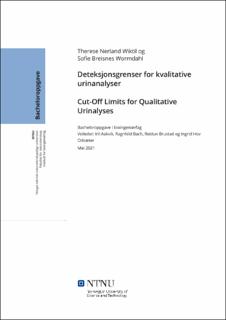| dc.contributor.advisor | Aakvik, Iril | |
| dc.contributor.advisor | Bach, Ragnhild | |
| dc.contributor.advisor | Brustad, Reidun | |
| dc.contributor.advisor | Odsæter, Ingrid Hov | |
| dc.contributor.author | Wiktil, Therese Nerland | |
| dc.contributor.author | Wormdahl, Sofie Breisnes | |
| dc.date.accessioned | 2021-09-25T16:59:01Z | |
| dc.date.available | 2021-09-25T16:59:01Z | |
| dc.date.issued | 2021 | |
| dc.identifier | no.ntnu:inspera:82853603:36912280 | |
| dc.identifier.uri | https://hdl.handle.net/11250/2783532 | |
| dc.description.abstract | Oppgaven er gitt av Avdeling for medisinsk biokjemi ved St.Olavs Hospital. Formålet med oppgaven er å undersøke responskurvene for testfeltene protein (albumin), glukose og blod (erytrocytter) på urinstrimmelen Combur 10Test M på to ulike reflektometre. Urinprøver positive for protein og glukose ble analysert på reflektometrene Roche Cobas u411 og Roche Urisys 1100. Reflektometrene gir et semikvantitativt resultat, og for å få et kvantitativt resultat ble de samme urinprøvene analysert på Siemens Advia Chemistry XPT. For blod ble det laget løsninger med kjente erytrocyttkonsentrasjoner som ble analysert på de samme reflektometrene. For å beregne responskurver for de gitte testfeltene ble probit-regresjon benyttet, og ut ifra responskurvene kan også deteksjonsgrensen til analytten på testfeltet beregnes. Statistikkprogrammet MedCalc ble brukt for å lage responskurvene. I statistikkprogrammet ble de kvalitative resultatene fra reflektometrene for glukose og protein plottet mot de kvantitative resultatene fra Siemens Advia Chemistry XPT. For blod ble de kvalitative resultatene fra reflektometrene plottet mot de kjente konsentrasjonene til løsningene.
For urinstrimmelen Combur 10Test M tilsvarer deteksjonsgrensen den konsentrasjonen hvor det er 90% sannsynlighet for positivt prøveresultat. Deteksjonsgrensen tilsvarer punktet C90 som kan finnes ut ifra regresjonsdataene tilhørende responskurven. Responskurvene ble laget i to sensitivitetsnivå for hvert testfelt på begge reflektometrene. På Roche Cobas u411 ble deteksjonsgrensen for protein bestemt til 57,6 mg/L for sensitivitetsnivå 1 og 253,8 mg/L i sensitivitetsnivå 2. For glukose på Roche Cobas u411 ble deteksjonsgrensen i sensitivitetsnivå 1 bestemt til 2,9 mmol/L og i sensitivitetsnivå 2 ble det ikke beregnet en representativ responskurve. For blod analysert på Roche Cobas u411 ble deteksjonsgrensen for sensitivitetsnivå 1 bestemt til 13 ery/μL og i sensitivitetsnivå 2 ble den bestemt til 23 ery/μL. På Roche Urisys 1100 ble deteksjonsgrensen for protein bestemt til 172,0 mg/L i sensitivitetsnivå 1, og 388,5 mg/L i sensitivitetsnivå 2. Deteksjonsgrensen for glukose på Roche Urisys 1100 ble bestemt til 3,5 mmol/L i sensitivitetsnivå 1, og 6,0 mmol/L i sensitivitetsnivå 2. For blod analysert på Roche Urisys 1100 ble deteksjonsgrensen i sensitivitetsnivå 1 bestemt til 17 ery/μL, og 41 ery/μL i sensitivitetsnivå 2.
Responskurvene, og deteksjonsgrensene, i sensitivitetsnivå 1 ble bestemt til å være de mest sannsynlige for testfeltene protein, glukose og blod på urinstrimmelen Combur 10Test M. | |
| dc.description.abstract | This thesis was given by Department of medical biochemistry at St. Olavs Hospital. The purpose of this thesis is to find the response curve for the test pads protein (albumin), glucose and blood (erythrocytes) on the urine strip Combur 10Test M on two different reflectometers. Urine samples positive for protein and glucose were analyzed on the reflectometers Roche Cobas u411 and Roche Urisys 1100. The reflectometers give a semi-quantitative result, and to get at quantitative result the urine samples were analyzed on Siemens Advia Chemistry XPT. For the blood test pad there were prepared solutions with known concentrations, and these were analyzed on the same reflectometers. Probit regression were used to calculate the response curves for the test pads, and from the response curves the cut-off limit were determined. The statistics program MedCalc was used to calculate the response curves. In the statistics program the semi-quantitative results from the reflectometers for protein and glucose were plotted against the quantitative results from Siemens Advia Chemistry XPT. For the blood test pad, the semi-quantitative results from the reflectometers were plotted against the known concentration of the solutions.
The cut-off limit for the urine strip Combur 10Test M is equal to the concentration where there is a 90% probability for a positive result. The cut-off limit corresponds with the point C90 which can be found from the regression data belonging to the response curve. The response curves were made in two different sensitivity levels for each of the test pads for both reflectometers. On Roche Cobas u411 the cut-off limit for protein was determined to be 57,6 mg/L for sensitivity level 1 and 253,8 mg/L for sensitivity level 2. For glucose on Roche Cobas u411 the cut-off limit was determined to be 2,9 mmol/L for sensitivity level 1 and for sensitivity level 2 there were not calculated a response curve. For blood on Roche Cobas u411 the cut-off limit was determined to be 13 ery/μL for sensitivity level 1 and 23 ery/μL for sensitivity level 2. On Roche Urisys 1100 the cut-off limit for protein was determined to be 172,0 mg/L for sensitivity level 1 and 388,5 mg/L for sensitivity level 2. For glucose analyzed on Roche Urisys 1100 the cut-off limit was determined to be 3,5 mmol/L for sensitivity level 1 and 6,0 mmol/L for sensitivity level 2. For blood analyzed on Roche Urisys 1100 the cut-off limit for sensitivity level 1 was determined to be 17 ery/μL, and 41 ery/μL for sensitivity level 2.
The response curves, and the cut-off limits, for sensitivity level 1 was determined to be the most probable for the test pads protein, glucose and blood on the urine strip Combur 10Test M. | |
| dc.language | nob | |
| dc.publisher | NTNU | |
| dc.title | Deteksjonsgrenser for kvalitative urinanalyser | |
| dc.type | Bachelor thesis | |
